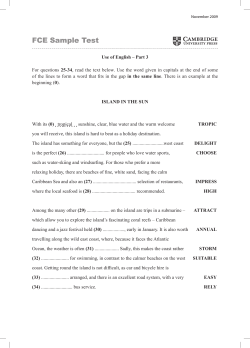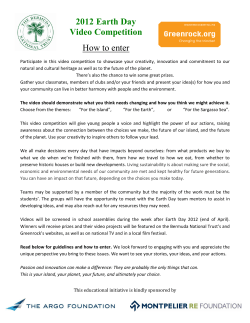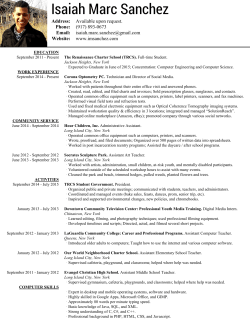
NETWORKING® 2020: - Networking Magazine
ADVISORY COMMITTEE HON. STEVE BELLONE ex officio Suffolk County Executive HON. EDWARD MANGANO ex officio Nassau County Executive HON. STEVE ISRAEL ex officio U.S. Congress HON. KENNETH LAVALLE ex officio NYS Senator JOHN D. CAMERON, JR., P.E. NETWORKING MAGAZINE 2020: Managing Partner Cameron Engineering & Assoc., LLP GUIDE TO ROBERT CATELL GOING GREEN Chairman Advanced Energy Research and Technology Center BILL CHALEFF ® Chaleff and Rogers Architects NANCY RAUCH DOUZINAS President Rauch Foundation “ There is no doubt that a few committed people can PETER ELKOWITZ change the world. In fact, it is the only thing that ever has.” President, CEO LI Housing Partnership AMY ENGEL Executive Director Sustainable Long Island ROZ GOLDMACHER President, CEO Long Island Development Corporation — Margaret Mead AMY HAGEDORN Board Member, co-founder Sustainable Long Island SARAH LANSDALE Director, Division of Planning, Environment; Dept. of Economic Development & Planning, Suffolk County NEAL LEWIS, ESQ. Executive Director The Sustainability Institute at Molloy College KEVIN MCDONALD Conservation Finance and Policy Director The Nature Conservancy, LI chapter MITCHELL H. PALLY Chief Executive Officer Long Island Builders Institute GORDIAN RAACKE Executive Director RELI ROBERT A. SCOTT PAUL TONNA MICHAEL E. WHITE Member of LI Commission for Aquafer Protection and member of Board of Governors for NYS SeaGrant New York State Assembly Committee on Environmental Conservation “New York has taken up the challenge of improving sustainability, recognizing the importance of developing new systems to protect and enhance our environment, while meeting the needs of a growing society. Our state has made significant progress in developing and utilizing cleaner energy, reducing pollution discharges into our waterways, lowering harmful air emissions and protecting our valuable forests, wetlands and waterbodies. From the vision and commitment of Gov. Cuomo through the hard work of local officials and the public, we continue to build a greener, sustainable New York that will improve environmental quality and our quality of life.” ® CEO, President Professional Evaluation Medical Group Adelphi University Commissioner, New York State Department Chair, of Environmental Conservation NETWORKING January 2015 13 President Adelphi University JOE MARTENS ROBERT K. SWEENEY Long Island Farm Workers Need Basic Labor Law Protections BY KARL GROSSMAN ® 14 NETWORKING January 2015 L ocally-grown food from small farms, an alternative to food from “factory farms,” has become, thankfully, popular across the United States and on Long Island where Suffolk County remains the top agriculture county in terms of value of annual produce in New York State. But there’s an issue not being addressed according to a Long Island professor: the situation of farm workers at these farms. “Food movement advocates and consumers, driven to forge alternatives to industrial agribusiness, have neglected the labor economy that underpins ‘local’ food production,” writes Margaret Gray in her just-published book, Labor and the Locavore. Thus, the call “to ‘buy local’ promotes public health at the expense of protecting the wellbeing of the farm workers who grow and harvest the much-coveted produce on regional farms,” added Gray, who is a professor of political science at Adelphi University in Garden City. “When it comes to factory farms, the public hasn’t “been reluctant to recognize the exploitation” of workers. But now being “overlooked” is “the role of hired labor in smallerscale agrifood production.” “Small farms,” she says in her book, published by the University of California Press, “like their factory farm counterparts, are largely staffed by noncitizens, immigrant workers.” But “the prevailing mentality within the alternative food movement has Dr. Margaret Gray, Associate Professor of Political Science not absorbed this reality.” at Adelphi University, has been recognized with “Food advocates and two prestigious awards for her recent book. their organizations display a tendency,” Gray goes on, “to conflate local, alternative, sustainable, and fair as a compendium of virtues against the factory farm that they so vigorously demonize. Yet this equation discourages close scrutiny of the labor dynamics by which small farms maintain their operations.” The situation for farm workers has long been a scandal in the United States. The great journalist, Edward R. Murrow, did one of his most important TV documentaries, “Harvest of Shame,” about the plight of migrant farm workers. Pointedly broadcast on Thanksgiving Day, 1961, it exposed the conditions for, as Murrow said, the “humans who harvest the food for the best-fed people in the world.” Paid outrageously small sums, exploited by crew leaders who recruited them, housed in awful dwellings, they constituted “workers in the sweat shops of the soil.” And critically, he stressed, laws that protected other workers specifically excluded farm workers. Suffolk County had a prominent place in “Harvest of Shame” with a migrant camp in Cutchogue, now closed, featured along with a section of Riverhead where, the documentary related, migrant farm workers who escaped the migrant stream have settled. Back then, most of the farm workers in Suffolk and elsewhere on the East Coast were black. “From World War II through the early 1970s, the vast majority of migrant [farm] workers in New York were African Americans from the South,” writes Gray. “This was a labor market profile...uniformly evident, whether on Long Island potato fields, Hudson Valley fruit and vegetable farms, Wayne County’s apple orchards...” Then in the 1980s, “Latinos came to dominate the regional agricultural labor market.” The farming picture in Suffolk County has changed dramatically as the county, although staying the state’s top agricultural county, has shifted to growing wine grapes at vineyards that have happily arisen and spread, and nursery stock especially ornamentals, plus still fruits and vegetables—but with no longer the dominance of potatoes. Yet, farm workers in Suffolk, statewide and nationally remain largely unprotected by law. As notes the Hauppauge-based organization, Long Island Jobs with Justice, farm workers “are excluded from basic labor law protections like minimum wage requirements, overtime pay and the right to join a union, to name a few.” A “Farm Workers Fair Labor Practices Act” has been considered by the New York State Legislature. It would establish an eight-hour workday for farmworkers, allow them overtime pay after eight hours, provide one day a week of rest, require they be paid the minimum wage, have the right to organize and bargain collectively, ensure their housing meets sanitary code standards, provide them with unemployment pay if laid off or fired and allow them to receive disability benefits. Gray concludes: “Buy local!” Yes, “support local farms,” she emphasizes, but at the same time “build a food movement that incorporates workers.” People, she says, should nicely explain to farmers “your food ethic and how it demands fair labor standards needs to be observed.” ■ Karl Grossman is an author, professor of journalism at the State University of New York/College at Old Westbury, hosts the nationally-aired television program, “Enviro Close-Up” produced by EnviroVideo (www.envirovideo.com), and is chief investigative reporter, WVVH-TV on Long Island. As notes the Hauppauge-based organization, Long Island Jobs with Justice, farm workers “are excluded from basic labor law protections like minimum wage requirements, overtime pay and the right to join a union, to name a few.” — http://longislandjwj.org/2014/06 /16/a-call-for-justice-for-new-yorks-farmworkers/ Gray’s Labor and the Locavore: The Making of a Comprehensive Food Ethic (University of California Press 2013) won the 2014 Book of the Year Award from the Association for the Study of Food and Society and the American Political Science Association (APSA) Labor Project. Second Annual Sustainability All-Star Awards PHOTOS COURTESY SUSTAINABLE LONG ISLAND Members of Sustainable Long Island’s Board of Directors, Russell Albanese, Amy Engel, Ron Shiffman, Lauren Furst, Charles Rich, Jeff Kraut, Dr. Miriam K. Deitsch, Jeffrey Arestivo, Len Axinn, Lidija Nikolic and Charlotte Biblow O Honoree, Andrew Kaplan, Executive Vice President, New York Community Bank and Amy Engel, Executive Director, Sustainable Long Island n Tuesday, December 2nd Sustainable Long Island hosted the Second Annual Sustainability All-Star Awards at Oheka Castle in Huntington, NY. Sustainable Long Island honored: The Albanese Organization, Chairman, Russell Albanese accepted and New York Community Bank, Executive Vice President Andrew L. Kaplan accepted, for their outstanding leadership in sustainability across Long Island. The two honorees were chosen because of their commitment to helping disadvantaged communities by implementing various projects and programs, engaging Long Islanders directly to help foster relationships and build capacity, and advancing sustainability initiatives Island-wide. Vanessa Pugh, Chief Deputy Commissioner, Suffolk County DOL LCA, Amy Hagedorn, Board of Directors, Sustainable Long Island, Honoree Russell Albanese, Chairman, Albanese Organization, Amy Engel Executive Director, Sustainable Long Island Sustainable Long Island to Conduct Comprehensive Recycling Analysis S ® Background Information According to the Environmental Protection Agency, Americans generate approximately 4.38 pounds of waste per person per day. Despite the fact that nearly 75% of this material is recyclable (recyclable or compostable), only 34.5% is actually recycled. In 2012, Americans threw away 251 million tons of trash. At a possible 75% recycle rate, this should amount to nearly 190 million tons of recycled materials. However, only 87 million tons of materials was recycled in this year, a difference of 102 million tons of additional waste to our landfills and incinerators. Under the Long Island Landfill ban, all landfills on Long Island have been closed since 1990. The reason being Long Island gets its water from underground aquifers that have the potential to become contaminated by these landfills. Waste can be handled in three ways on Long Island: burning, recycling, or out of state land filling. Long Island has four incinerators that burn trash in order to convert it into energy such as electricity. Of the estimated 4.6 million tons of waste generated on Long Island each year, 1.6 million tons get incinerated, 1.9 million tons get recycled and the remaining 1.1 million tons are shipped off the island to landfills in Ohio, Pennsylvania, and Virginia. Sustainable Long Island is a nonprofit organization advancing sustainability through community revitalization, brownfield redevelopment, and food access initiatives. Sustainable Long Island connects public and private resources and expertise with communities that need them the most while promoting economic development, environmental health, and social equity. For information, call (516)-873-0230 or visit www.sustainableli.org ■ NETWORKING January 2015 15 ustainable Long Island has been awarded $7,500 from the Angela and Scott Jaggar Foundation to conduct a comprehensive analysis of recycling on Long Island. The analysis will consist of examining existing recycling laws and codes to clearly outline challenges and obstacles affecting the progression of recycling practices across Nassau and Suffolk Counties. "Establishing a baseline of data on recycling is a critical first step before advocacy changes can be made," said Amy Engel, Executive Director of Sustainable Long Island. "Very little information exists about the rates of recycling throughout Long Island, the policies that govern it, and what more can be done to encourage and facilitate the practice." The analysis will look at ways to reduce the waste stream itself, highlight impediments to recycling markets, and look at best case practices and success stories from other parts of the country from which to learn. The information gathered will allow stakeholders and decision-makers to examine Long Island's recycling system through a comprehensive lens. The analysis and review of existing recycling laws/codes on Long Island will gather data from numerous secondary sources, including the US Environmental Protection Agency, Waste Reduction and Management Institute, research teams from Long Island University Post and Stony Brook University, and data from Long Island's 13 towns and two cities. Recycling can be a way to reduce reliance upon landfills and incinerators. It is the hope that thorough research will lead to dialogue, which will then lead to policy change, market change, and finally, positive impact on Long Island communities. Suffolk County Water Authority Hosts Educational Seminar PHOTOS BY CHRISTINE CONNIFF SHEAHAN Rosemary Mascali, Manager, Transit Solutions, Carrie Meek Gallagher, Chief Sustainablility Officer, SCWA, Ellen Hanzl, Operations & Events Manager, Seatuck Environmental Association, Enrico Nardone, Esq, Executive Director, Seatuck Environmental Association Chris Niebling, Lab Manager, Organic Area, SCWA, Carrie Meek Gallagher, Chief Sustainablility Officer, SCWA T Steven Smith, National Energy Connection, Jack Monti, Hydrologist, U.S. Geological Survey (USGS), Rich Brown he Suffolk County Water Authority (SCWA) hosted an educational tour and seminar for the Seatuck Sustainability Business Council at their Hauppauge facility. Topics included a State of the Aquifer presentation and discussions on: Topography, Population, Land Use & Cover, Hydrologic Cycle, Precipitation and Recharge, Surface Water, Groundwater, Water Availability, Water Suitability, and Potential Hazards. Following was an update on the Long Island Commission for Aquifer Protection, What Businesses Can Do to Protect the Aquifer and a Tour of Education Center and SCWA Drinking Water Laboratory. ■ Sue Avery, Nature’s Edge Amanda Commando, Assistant Supervising Chemist, Inorganic Area, SCWA L to R: Lisa Burch (partially obscured in background), NSLIJ Health Systems, Sue Avery, Nature’s Edge, Katie Dunne, (background), 511 NY Rideshare, Ellen Lalier, Seatuck Volunteer, Rosemary Mascali, Transit Solutions, Marissol Mallon, Supervising Chemist, Inorganic Area, SCWA Ellen Lalier, Katie Dunne and Rosemarie Clipper Gavin Marsden, Assistant Supervisor and Catherine Nicoletti, Supervisor, Bacteriology and Sample Collection, SCWA 16 NETWORKING® January 2015 Energy Prices Expected To Be Lower This Winter A lbany, NY – The New York State Public Service Commission, in an effort to avoid a repeat of last winter’s large price increases, announced that utilities and third-party energy providers have agreed to provide customers with more information and more refined tools to help customers manage their energy bills. In addition, the Commission said it is expanding its own outreach efforts, including launching a newly enhanced website that can help residential and small commercial consumers identify energy products to meet their needs to help control energy costs. “The unprecedented cold weather last winter was particularly challenging for the many people who experienced unusually high energy bills,” said Commission Chair Audrey Zibelman. “To help ensure such problems are avoided, we have been working with the utilities and third-party energy providers on ways to reduce price volatility and provide more options to help consumers better manage and control their energy bills.” In terms of energy resources, utilities providing natural gas service in the state have adequate supplies, delivery capacity, and storage inventory to satisfy customer demand under severe winter conditions. While bill impacts will vary by utility, natural gas bills in general are expected to be lower this winter compared to last winter. On the electric side, this winter’s (December through March) commodity prices statewide are expected to be lower, although commodity prices can vary due to weather and other conditions. On average, a residential customer using 600 kWh per month is expected to pay about $55, or about 20 percent, less than last winter, but the amount will vary by utility. A website, accessible from www.dps.ny.gov, allows customers to easily find fixed price energy products for electricity and natural gas service, identify those that may meet their needs, and directly link to providers of those products. ■ GREEN THOUGHTS Assessing the Risks of Genetically Engineered Crops COMPILED BY SALLY GILHOOLEY PHOTO BY QUINN DOMBROWSKI, COURTESY FLICKR Proponents of genetic engineering (GE) — whereby DNA from unrelated species is combined to produce improved or novel organisms — insist that the benefits of increased crop yields and less agricultural waste outweigh the potential risks, but many environmental and public health advocates aren’t convinced. According to the Union of Concerned Scientists (UCS), one risk of GE is that our new “frankencrops” could become invasive, toxic to wildlife, or dangerous in other as-yet unknown ways. “But the most damaging impact of GE in agriculture so far is the phenomenon of pesticide resistance,” reports UCS, adding that millions of acres of American farmland are infested by weeds that have become resistant to Monsanto’s popular herbicide glyphosate (known to most by its trade name Roundup). “Overuse of Monsanto's ‘Roundup Ready’ trait, which is engineered to tolerate the herbicide, has promoted the accelerated development of resistance in several weed species.” As a result, farmers are now turning to older, more toxic herbicides—and agribusiness companies are responding in kind with new rounds of GE crops engineered to tolerate these older chemicals. UCS worries that the process repeating itself is only leading us down the path of plants evolving quickly to overcome our defenses however technically brilliant they may be. As for health risks, UCS acknowledges that eating refined products derived from GE crops is unlikely to cause health problems, but maintains that inserting a gene from one organism into another could still have unintended health consequences. For example, those with food-borne allergies could be at increased risk for reactions given the combination of genes in what looks like any other vegetable or piece of fruit. “This phenomenon was documented in 1996, as soybeans with a Brazil nut gene — added to improve their value as animal feed — produced an allergic response in test subjects with Brazil nut allergies,” reports UCS. Given these risks, some 21 countries and the F European Union (EU) have instituted policies requiring foods created with GE technology to be labeled as such so consumers can know what they are buying and putting into their mouths. EU rules mandate that if any ingredient in a food has 0.9 percent or higher of genetically modified organisms, it must be marked accordingly on its packaging. Environmentalists in the U.S. would like to see the federal government put in place a similar policy — research from the non-profit Just Label It found nine in 10 Americans to be in favor of mandated GE labeling — but lobbying interests from agricultural states with a vested interest in selling more GE products still hold lots of sway over elected officials. So for now, Americans concerned about what’s in their food will need to do their own homework regarding what’s safe to put on their dinner tables. Luckily some natural foods retailers are making it easier for consumers intent on avoiding GE foods. Whole Foods, for one, is working toward full disclosure via labeling in regard to which of the foods on its store shelves contain GE ingredients. While Whole Foods may be a pioneer in this regard, environmentalists are hoping other U.S. grocery store chains will follow suit so that Americans can decide for themselves whether or not to take the risk of eating GE foods. Contacts: UCS, www.ucsusa.org; Just Label It, justlabelit.org. EarthTalk® is written and edited by Roddy Scheer and Doug Moss and is a registered trademark of E - The Environmental Magazine (www.emagazine.com). Send questions to: earthtalk@emagazine.com. ollow Me to Masdar: The First Carbon-Free City is a documentary film introduced at the Hamptons Film Festival about building a carbon-free city, Masdar. In 2007, the government of Abu Dhabi, an emirate that controls 8% of the world’s oil reserve, announced it would build Masdar, the world’s first zero-carbon city. In his film, director John Paul Redmond, a Captain in the U.S. army who served in Kunar, Afghanistan, returns home, falls in love with the girl of his dreams, goes to film school and finds an answer to the world’s energy crisis in Masdar City (which means source in Arabic.) In 2009, the International Renewable Energy Agency made Masdar City its world headquarters. See htff.com T he Sierra Club is inviting visitors to its site to contact beverage club giants asking them to slash oil use in their vehicle fleets. According to the Club, the soda industry owns more than 100,000 vehicles and uses more oil to fuel them than any other industry. This is among Sierra Club’s first efforts of the new Future Fleet initiative and ForestEthics who are asking supporters to visit their site and send in a letter (they have provided one) requesting beverage companies to slash oil use. Go to sierraclub.org G overnor Andrew Cuomo continues to position New York as a recreation destination. This year’s state budget included $6 million in NY Works funding to support the creation of 50 new land and water access projects connecting hunters, anglers, bird watchers and others to more than 380,000 acres of existing state and easement lands that have been underutilized. To date, construction has started on all 50 sites, with 14 of them complete. Approximately 30 projects will be completed by the end of the year. For more information on these access projects, visit: http://www.dec.ny.gov/outdoor/991 63.html. S NETWORKING® January 2015 17 upporting the goals of the administration’s Climate Action Plan, the Energy Department announced $15 million in available funding to help integrate distributed, on-site solar energy systems into the nation’s electrical grid. With more solar power installed in the United States in the last 18 months than in 30 years prior, solar is shattering records. As more solar comes online, the Energy Department is working to address the challenges of solar power, such as the variability of available sunshine during the day, and developing solutions to better integrate solar photovoltaics (PV) with electric power systems throughout the grid. See eere-network -news@ee.doe.gov ■ Governor Cuomo Bans Fracking in New York State Price of Solar Panels Installed on Roof Tops is Lower Than Ever R PHOTO COURTESY NEW YORK LEAGUE OF CONSERVATION VOTERS New York State Department of Health Completes Review of High-Volume Hydraulic Fracturing Acting DOH Commissioner Zucker Recommends Activity Should Not Move Forward in NY State T he state Department of Health (DOA) has completed its public health review of highvolume hydraulic fracturing (HVHF) and Acting DOH Commissioner Dr. Howard Zucker recommended that high-volume hydraulic fracturing should not move forward in New York State. Dr. Zucker announced his findings and recommendations at a Cabinet Meeting in Albany. “I have considered all of the data and find significant questions and risks to public health which as of yet are unanswered,” said Dr. Zucker. “I think it would be reckless to proceed in New York until more authoritative research is done. I asked myself, ‘would I let my family live in a community with fracking?’ The answer is no. I therefore cannot recommend anyone else’s family to live in such a community either.” In 2012, Department of Environmental Conservation (DEC) Commissioner Joe Martens asked the DOH Commissioner to conduct a review of the draft Supplemental Generic Environmental Impact Statement for High-Volume Hydraulic Fracturing (SGEIS). Dr. Zucker’s report fulfills that request. As a result of Dr. Zucker’s report, Commissioner Martens stated at a recent cabinet meeting that he will issue a legally binding findings statement that will prohibit HVHF in New York State at this time. “For the past six years, DEC has examined the significant environmental impacts that could result from high-volume hydraulic fracturing,” DEC Commissioner Joe Martens said. “DEC’s own review identified dozens of potential significant adverse impacts of HVHF. Further, with the exclusion of sensitive natural, cultural and historic resources and the increasing number of towns that have enacted bans and moratoria, the risks substantially outweigh any potential economic benefits of HVHF. Considering the research, public comments, relevant studies, Dr. Zucker’s report and the enormous record DEC has amassed on this issue, I have directed my staff to complete the final SGEIS. Once that is complete, I will prohibit high-volume hydraulic fracturing in New York State at this time.” ■ 18 NETWORKING® January 2015 DEC Commissioner Martens will issue a findings statement early this year to prohibit High-Volume Hydraulic Fracturing Source: New York State Department of Environmental Conservation. DOH’s review can be found at: http://www.health.ny.gov/ ooftop solar panels have always been the province of well-to-do, eco-friendly folks willing to shell out extra bucks to be green, but that is all starting to change. According to the National Renewable Energy Laboratory (NREL), the cost of putting solar panels on a typical American house has fallen by some 70 percent over the last decade and a half. And a recent report from Deutsche Bank shows that solar has already achieved so-called “price parity” with fossil fuel-based grid power in 10 U.S. states. Deutsche Bank goes on to say that solar electricity is on track to be as cheap or cheaper than average electricity-bill prices in all but three states by 2016—assuming, that is, that the federal government maintains the 30 percent solar investment tax credit it currently offers homeowners on installation and equipment costs. But therein could lie the rub. The federal tax credit for residential solar installations expires in 2016, and it’s anybody’s guess whether and to what extent the Republicandominated Congress will renew it. Legislative analysts report that while Congress is unlikely to abandon the program entirely, big cutbacks could be on the way. But Deutsche Bank maintains that even if the credit is reduced to 10 percent, solar power would still achieve price parity with conventional electricity in some 36 states by 2016. Meanwhile, homeowners in states where additional local incentives are available and there’s lots of sunshine—such as across the Southwest—may in fact already be able to power their homes cheaper with the sun than from the grid. Homeowners looking to go solar should check out the Database of State Incentives for Renewable and Efficiency (DSIRE), a free online database of all the different state and local incentives for solar and other forms of renewable energy. And prices for solar are expected to keep falling as technologies improve and financing becomes more affordable. Solar leasing has helped hundreds of thousands of Americans realize the dream of going solar without breaking the bank. The companies behind such programs—SolarCity, SunRun and others—take care of installation, maintenance and upgrades while the customer ends up paying about as much for clean, green power as for grid power from coal or other fossil fuels. Of course, solar is still a bit player in the scheme of things in terms of U.S. and global electricity production. But with costs coming down, we can expect to see a lot more solar panels going up on rooftops across the land in the coming decade. Environmentalists concerned about our changing climate say the sooner the better, as our dependency on coal and other fossil fuels for electricity is a big contributor to global warming. Congress will definitely be considering whether or not to extend the solar investment tax credit when it reconvenes in 2015. If you’re part of the silent majority of Americans who would like to see the credit extended so that middle class Americans can continue to afford to convert to solar power, be sure to speak up and let your Congressional delegation know. Contacts: Deutsche Bank, www.db.com; National Renewable Energy Laboratory, www.nrel.gov; SolarCity, www.solarcity.com; SunRun, www.sunrun.com. ■ EarthTalk® is written and edited by Roddy Scheer and Doug Moss and is a registered trademark of E - The Environmental Magazine (www.emagazine.com). Send questions to: earthtalk@emagazine.com
© Copyright 2025









